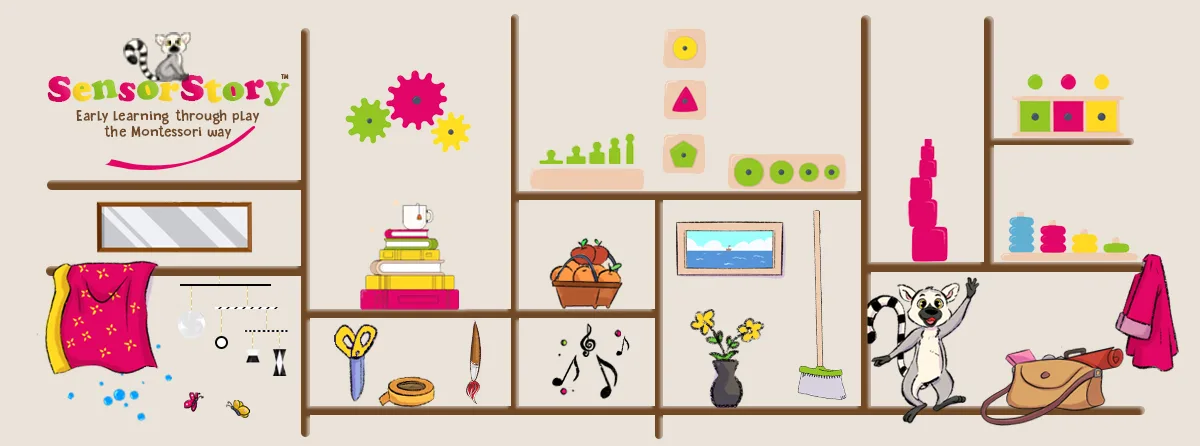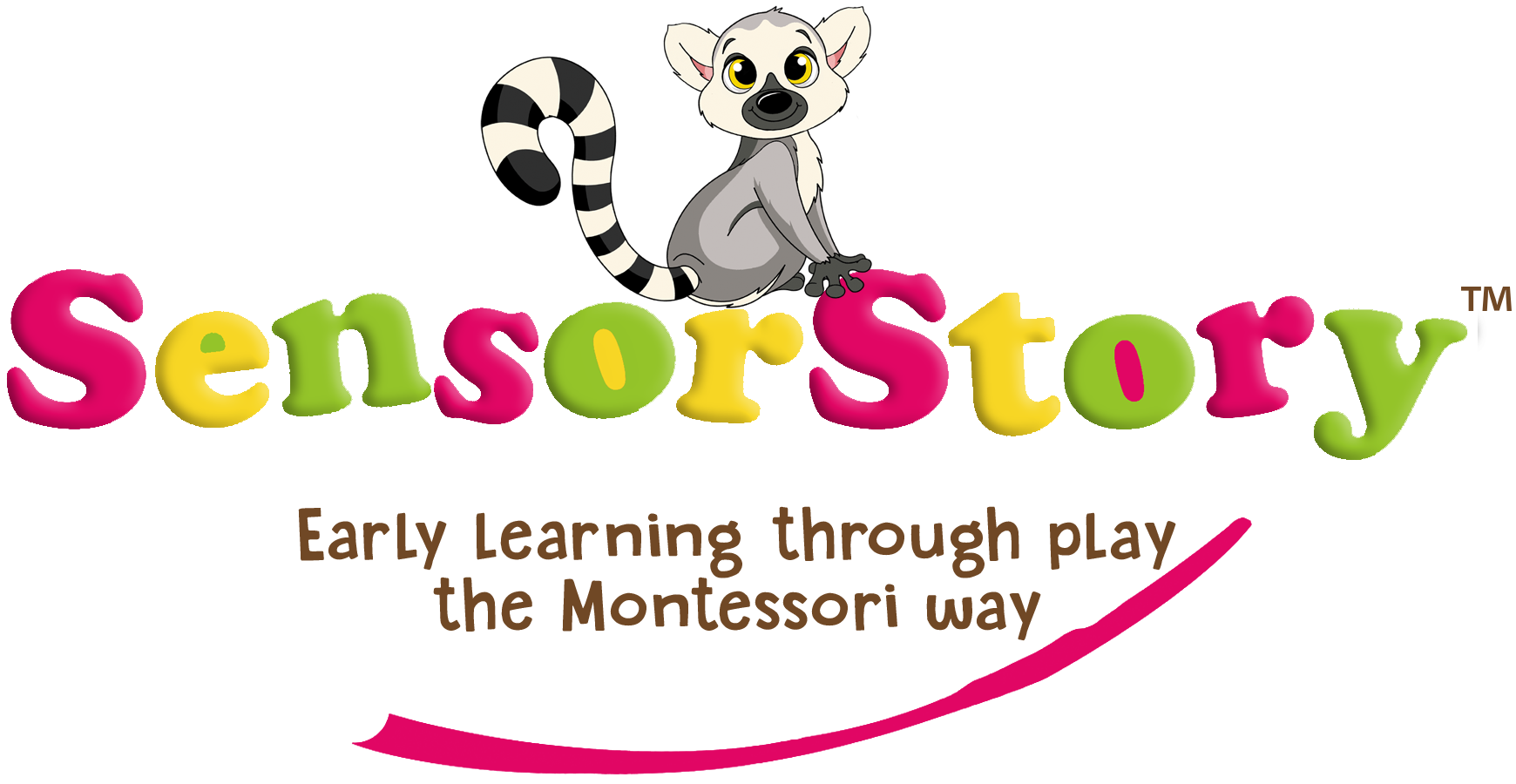We've put together a detailed list of at-home Montessori-aligned activities suitable for a 11-month-old.
Here you will see age-appropriate activities for all areas, in our Ultimate Series Of Activities to try at home, where the emphasis is on providing a prepared environment and allowing the child to actively engage in self-directed learning.
So what is my child working on mastering at this age?
Between the 9-12 month age, typically we will see your little one focused on sensorimotor exploration, refining gross and fine motor skills, early language development, fostering independence in simple tasks, and establishing a sense of order and routine in their environment.

1. Sensory Exploration:
* Encourage baby to explore different scents by providing them with a variety of smelling materials like flowers, herbs, or spices. You can also create a scent basket filled with different smelling objects like lavender sachets, cinnamon sticks, or citrus peels.
* Create a light box filled with different coloured objects.
* Introduce your baby to different tastes and textures by offering them a variety of healthy foods to try, such as soft fruits, cooked vegetables, or whole-grain crackers. You can also create a taste-safe sensory bin filled with edible materials like cooked pasta, cereal, or fruit.
* Introduce touch and feel books with different textures for tactile exploration.
* Allow baby to play with water in a shallow basin, providing various containers for pouring.
2. Fine Motor Skills:
* Provide baby with child-safe scissors and show them how to hold and cut along the lines of paper strips.
* Provide your baby with a shirt with large buttons and show them how to button and unbutton the shirt. This activity helps develop finger strength and hand-eye coordination.
* Wet pouring: offer baby a small pitcher and a cup and show them how to pour water from the pitcher into the cup.
* Have large wooden beads and a string and show them how to place the beads onto the string.
* Provide your baby with small objects like pom-poms or cotton balls and show them how to pick them up using their fingers. This activity helps develop finger strength and fine motor skills.
* Stacking blocks: Offer baby large blocks and show them how to stack them, helping to develop hand-eye coordination and spatial awareness.
3. Movement:
* Provide your baby with a safe and sturdy climbing structure like foam steps, a Pikler arch, or a climbing mat.
* Create an obstacle course using pillows, cushions, tunnels, and other safe objects from around the house to encourage crawling and movement.
* Offer a ball pit and encourage your baby to play with balls to help develop hand-eye coordination and gross motor skills.
* Provide your baby with a steady and sturdy walker wagon to support them as they take their first steps.
* Allow your baby to climb a low step or stairs, under direct supervision, to develop gross motor skills and spatial awareness.
* Play some music and move and dance to the rhythm with your baby.
4. Practical Life Skills:
* Provide your baby with a small sponge or cloth and show them how to wipe a table or other surface.
* Offer baby with clothes that are easy to put on and take off, such as pants with an elastic waistband or a shirt with large buttons, helping to develop independence and self-care skills.
* Have a small broom or dustpan available in baby's environment and show them how to sweep up small messes, helping to develop responsibility and care for the environment.
* Involve your baby in simple food preparation tasks like washing fruits and vegetables or tearing lettuce leaves, developing independence and self-care skills.
* Involve your baby in caring for plants by watering them or helping to repot them, developing responsibility and care for the environment.
5. Language Development:
* Read books with your baby and encourage them to turn the pages, choosing books with few words and beautiful illustraions or realistic photos.
* Sing songs and nursery rhymes with your baby to help them develop an ear for language and rhythm.
* Talk to your baby throughout the day and describe what you are doing. Use simple words and short sentences.
* Engage in Baby Sign Language with your baby. Teach your baby simple signs like “more,” “all done,” and “milk” to help them communicate before they can speak. To learn more about using Baby Sign Langauge click here.
6. Art Exploration:
* Finger painting: use non-toxic, washable paint and let your baby explore the texture and colours by dipping their fingers in the paint and creating patterns on paper.
* Add a small amount of paint to a sealable freezer bag and securely seal it. Allow baby to squish and move the paint around inside the bag.
* Create DIY sensory paints using safe ingredients like pudding or yogurt mixed with natural food colouring.
* Use everyday objects like sponges, cotton balls, or leaves to create different textures and patterns on paper.
* Provide your baby with large, non-toxic crayons and let them scribble on paper. In Montessori we prefer to steer away from 'colouring-in' books.
* Tearing and pasting: offer your baby some coloured tissue paper let them tear shapes. Provide them with glue and a piece of paper or card to stick the pieces onto.
* Use everyday objects like corks to create stamps. Dip them in paint and encourage your baby stamp them on paper to create patterns.
7. Music:
* Singing is a great way to introduce your baby to music. You can also use props like puppets to make it more engaging.
* Rhythm sticks: Offer your baby two wooden sticks and encourage them to explore the sound and rhythm by tapping them together or on different surfaces.
* You can make shakers at home by filling plastic bottles with rice, beans, or beads.
* Drumming: use a small drum or a pot and a wooden spoon to create different beats and rhythms.
* Create a designated music and movement area with various musical instruments.
8. Nature Exploration:
* Set up a small nature tray with safe natural objects like pinecones, shells, or leaves for sensory exploration.
* Create a nature walk by exploring outdoor spaces, observing trees, flowers, and the environment.
* Introduce simple gardening activities with safe, child-friendly plants.
* Bug hunt: Go on a bug hunt with your baby and let them observe different insects like ants, beetles, and butterflies. You can also provide them with a magnifying glass to get a closer look.
* Use natural materials like leaves, flowers, and twigs to create art.
9. Object Permanence:
* Play peek-a-boo with soft cloths or scarves to reinforce the concept of object permanence.
* Object permanence box: This is a box with a hole on the top and a drawer at the bottom where your baby can drop a ball or a small object through the hole and retrieve it from the drawer. This activity helps your baby understand that objects continue to exist even when they are out of sight.
* Nesting cups: Provide baby with a set of nesting cups and encourage them to stack the cups in order of size.
* Cube in a box: This is an imbucare activity that involves placing a cube inside a box with a hole. You can show the baby how to take the cube out and put it back in. This can help the baby develop hand-eye coordination, spatial awareness, and object permanence.
* Place a soft cloth over a toy and encourage baby to reveal it.
* Introduce soft books with fabric flaps that your baby can lift to reveal hidden pictures or objects.
* Place a soft toy inside a cloth bag and allow baby to explore reaching inside to retrieve it.
* Create a simple pop-up tent using soft fabric, allowing baby to enter and exit, experiencing moments of disappearance and reappearance.
10. Social Interaction:
* Arrange playdates with other children, helping to develop social skills, empathy, and emotional regulation by learning to take turns, and communicate with others.
* Participate in simple turn-taking activities, such as passing a soft ball back and forth.
* Engage in responsive communication, mirroring baby's sounds and expressions.
* Play peek-a-boo with your baby using a blanket or a scarf. This activity helps baby develop object permanence and social skills by learning to anticipate your return.
* Read books with your baby and encourage them to turn the pages.
* Provide your baby with soft dolls and encourage them to play pretend. This activity helps the child develop language skills, cognitive skills, and social skills by learning to interact with others and express emotions.
11. The Whole Child Development:
* Attend our weekly SensorStory Baby and Toddler Montessori parent-child sensory classes! Follow this link to enrol your infant here.
We hope we have given you some inpiration for activities to do with your 11-month-old!
Remember, follow the child, adapting activities based on your observation of your baby's developmental stage and individual interests. The key in a Montessori environment is to provide your child with real, purposeful, and age-appropriate tools and materials that allow them to engage in activities independently and at their own pace.
Disclaimer: Adult supervision is required for any activity suggested by SensorStory. Please follow any directions and/or warnings on the labels(s) of any materials used during such activity & be aware of any potential choking hazards or allergies.
Click here to see our
Activities To Do With An 12 Month Old
FAQ.
